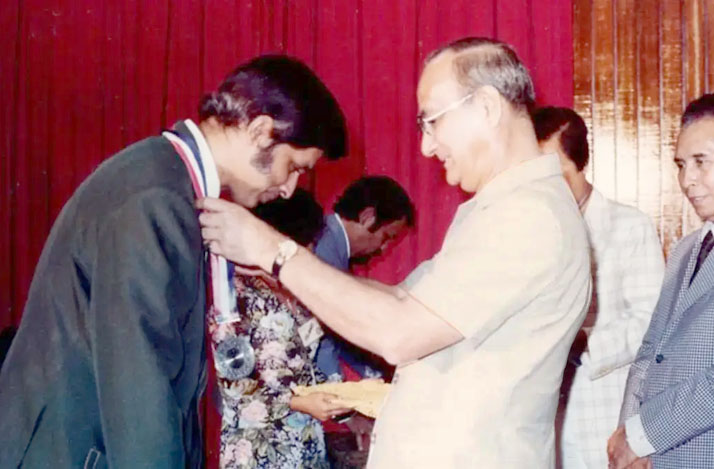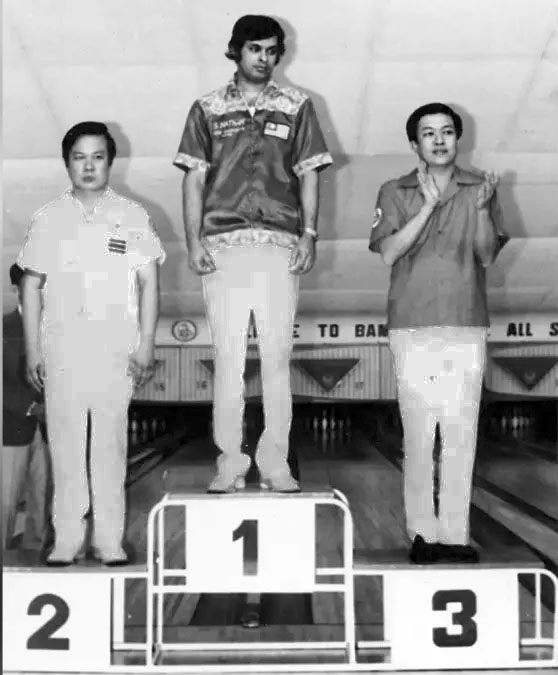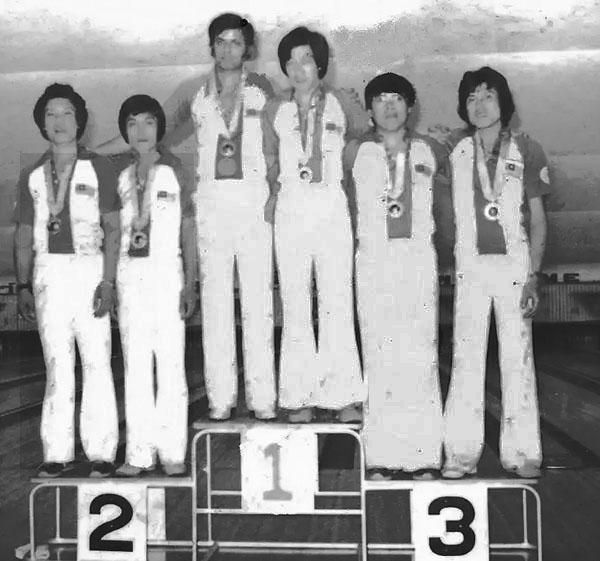
The doctor who began
Malaysia's tenpin bowling revolution

Dr PS Nathan who ruled the bowling alleys in the 1970s, with (right)
his trophies after winning the national masters title in 1974
Frankie D'Cruz
25 Sep 2024
PETALING JAYA: In the 1970s, traditionalists mocked a suggestion by Dr PS Nathan that tenpin bowling would be a major sport in Malaysia. While Nathan's passion for the sport was as clear as the sound of a perfect strike, the doubters had their reasons because bowling then was a parlour game.
Amid the snubs, Nathan tackled the odds, ignored the naysayers, silenced the critics and rolled Malaysian bowling to the world stage.
In 2018, a conversation about making bowling an important sport between former Olympic Council of Malaysia (OCM) president, Tunku Imran Tuanku Ja'afar, and Nathan came to light.

Five years after forming the Malaysian Tenpin Bowling Congress,
Dr PS Nathan received a sports leadership award in 1979 from
then Prime
Tunku Imran told reporters: "I would consider myself a traditionalist. Dr Nathan once told me tenpin bowling was going to be big and I told him how can a parlour game be huge. He proved me and many people wrong. "I have learnt that you cannot ignore such things, and in fact ignoring it (new sports) could be dangerous. It's all about having a good system and ensuring it is done properly."
He made the remarks after the youth and sports ministry announced that skateboarding and climbing had been included in the national sports council's agenda.
In sport, the good is raised to great, the great to incredible, the remarkable to fantastic, and on, upwards, into the stratosphere. Nathan, who was a dermatologist by profession, deserves every superlative thrown at him.
Bowling's kingpin
The tireless mastermind found ways of making a great Malaysian sport even greater. For Nathan, it was a victory for resolve, for team spirit and oneness, for an absence of ego and for good old-fashioned hard work. These are all qualities that become easier to admire in a world where fame and success is too often the preserve of the ordinary and shallow.

Dr PS Nathan was the first Malaysian bowler
to win an international title at the SEAP Games in 1975.
Nathan's 50 years as keeper of Malaysian bowling, gave us all that we love about the sport: faith, glory, optimism and romance. As a kegler and administrator who built the foundations of the Malaysian Tenpin Bowling Congress (MTBC), he is a unique example of loyalty to one sport, one association.
Nathan was the longest-serving president of any national sports association in Malaysia and also served as the president of world and Asian bowling bodies. He was instrumental in getting bowling included in the 1998 Kuala Lumpur Commonwealth Games, the only time the sport has been featured in the history of the Games. Malaysia won two gold medals and a silver from the five events contested.
Nathan tried in vain to get bowling into the Olympics, and once said it will never be an Olympic sport, largely because spectators are limited at venues, hence no appeal to television broadcasters. As a player, he was the first national bowling champion in 1974, the same year he founded and shepherded MTBC, two roles he balanced skilfully. His popularity in the sporting circle got him appointed as vice president of OCM and his leadership qualities made him an easy choice for chef de mission for the 1991 Manila Sea Games.
His is no normal legacy. It is so overpowering that Malaysian bowlers at the ongoing Asian Championships in Bangkok have won six medals so far, a fitting farewell for Nathan who passed away on Sunday, aged 91.
It was also in Bangkok that Nathan, who took up bowling at 35 and emerged the national masters champion in 1974, became the first Malaysian to strike bowling gold in an international championship. At the 1975 SEAP Games, he won the men's singles event, beating Thailand's Likit Fahpyochon by a single pin. That title was not just his triumph but also Malaysian bowling's arrival on the international stage.
Three years later when bowling was staged for the first time at the Asian Games, also in Bangkok, Nathan, along with JB Koo, Allan Hooi, Edward Lim and Holloway Cheah won the gold medal in the five-man team event. They captured Malaysia's first gold at the Games, with the only other gold coming from Saik Oik Cum in athletics in the 400m.
Sweaty outfits and champagne
Yesterday, Cheah recollected the stress and fun they experienced in Bangkok, with Nathan in the centre of the story. He said after the first break of the team event, Malaysia were leading the host nation by 144 pins, when team captain Nathan stopped them from returning to their hotel. Nathan, who was also the MTBC president, told them they were not allowed to have a change of outfits.

The Malaysian bowlers who won the gold medal
at the 1978 Asian Games, with Dr PS Nathan (third from left).
As it was pointless travelling all the way to their hotel, Koo requested they have a bath at a nearby hotel massage parlour and MTBC pays for the shower. They returned to the bowling venue and continued their game in the same sweaty outfits. In the ensuing marathon session, they produced magic.
For their excellent performance, the late Mohamed Rahmat, the chef-de-mission, promised the players a bottle of champagne. Koo told him that the one bottle he was offering was just good enough for him. On reaching their hotel rooms, there were three bottles waiting for them to celebrate.
World-beaters, going mainstream
At the 1979 World Tenpin Bowling Championships, the amateurs, Koo, Hooi and Lim beat the semi-professional Americans at their own game to win the title. They did something extraordinary at a time when, with the exception of badminton, Malaysia had never become world champions in any other sport.
Their story is fascinating because before the tournament in Manila, they bowled six games every morning for six months at Federal Bowl in Kuala Lumpur before going to work, at their own expense. The trio were world-beaters, but upon their return from Manila, the heroes missed the strident beats of the kompang and the appreciative pat on the back from the government.
The press reported that only a handful of MTBC members were present, with sports ministry representatives glaringly absent. National spotlight only fell on them when former prime minister Hussein Onn later presented medals to them, and Koo was picked as the 1979 national sportsman of the year.
It was a three-bagger (three strikes in a row) because Shirley Chow was the national sportswoman of the year, while Koo, Hooi and Lim bagged the team (under six players) award. With Nathan at the helm, bowling moved from the margins to the mainstream of Malaysian sport.
The young began to take up the game and tenpin alleys boomed as Malaysia was bowled over by the heroics of Nathan's team. In tracing the epic narrative of how bowling was transformed, a larger story emerges: of how a less popular sport itself changed, and how as a spectator sport it moved decisively on a trajectory toward what it has become today.
The father figure
Nathan had a thriving medical practice, but almost daily, he was at the lanes to observe the national players at training or creating new plans and updating development programmes. He kept pace with the radical changes in the game, with the sole intention to keep producing talent and to maintain the tradition of players returning home with medals from tournaments every year.
Many remember Nathan, born in Seremban and educated at St Paul's Institution and later at the Victoria Institution in Kuala Lumpur, for his warmth, curiosity, openness and joy.

The warmth, curiosity, openness and joy
of Dr PS Nathan endeared him to many.
The tributes that poured in spoke of him being a close friend and life advisor, bringing joy to many. He stepped down as MTBC president in May but remained in close contact with members of the bowling fraternity here and abroad.
The obituary mentions his personal assistant Muriel Lee and Indonesian carer Khamimah because they had faithfully served Nathan for 32 years and 23 years respectively. Nathan is survived by his wife Malathy Satkuna, a former national bowler, daughter Malini and son Dr Ruban, and six grandchildren.
 The V.I. Web Page
The V.I. Web Page